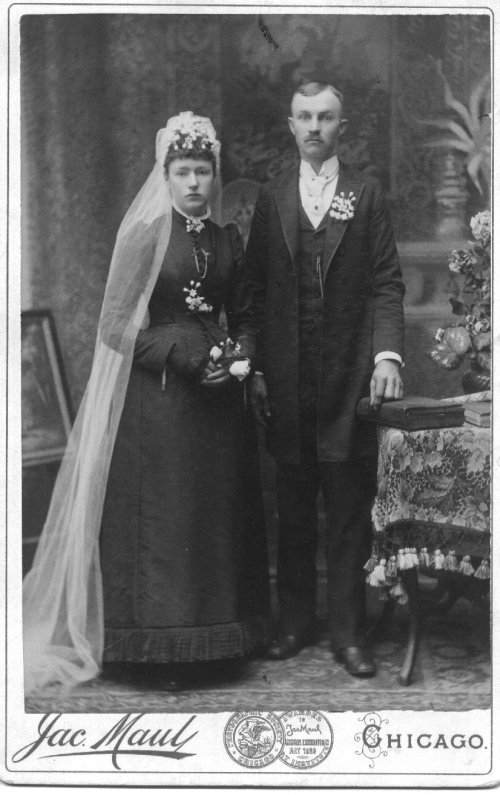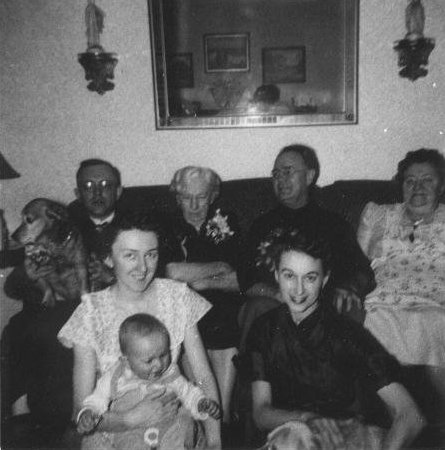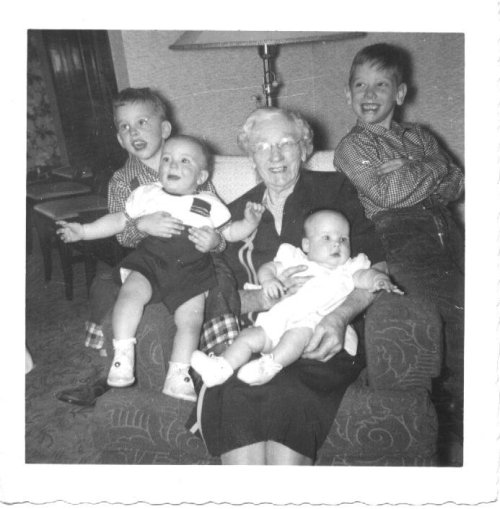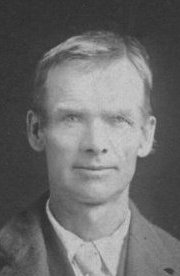
I was adding a couple of new names to my Family Tree Maker 2019 database last week when I realized that Martha Winkelman Duntemann’s 150th birthday was coming up. Today’s the day, and for me it’s worth some modest celebration. Martha (who died in 1967) is now 150 years old–and I knew her. That seems odd, bordering on the impossible somehow.
But it’s true. Martha was born on a Bensenville, Illinois farm on April 10, 1871. I have a scan of an old plat map somewhere with the names of the farmers on their acreage. I believe the Winkelman farm was on land now part of O’Hare Field. The Duntemann farm certainly was. In fact, I discovered with a little mapwork that the Duntemann farmhouse was almost directly where the airport’s boiler plant is. You see it from the freeway coming out of the main terminal on your right. Interestingly, my father was the gas company liaison engineer to the city when they built the gas-fired boiler plant in the early 1960s. He never knew (as best I recall) that his great-grandfather’s farm was right there.
Martha married Frank W. Duntemann on January 31, 1892. She was 19; he 24. They had two sons: Harry George Duntemann, born on October 20 of that year, and Elvin Frederick Duntemann, born July 16, 1895. Harry was my grandfather, and Uncle El was a jolly, goodhearted man whom I saw less often than I should have. Martha’s husband Frank died in 1936. My father was named after him. The family photo shown below is undated, but by the ages of the boys I’m guessing 1900.

Frank did not go into farming as most of his four brothers did. Instead he established a general store in the little railroad town of Orchard Place, Illinois, roughly where Higgins Road crosses the Soo Line railroad. Soon after the store opened, Frank got the job of Orchard Place postmaster, which he held until a year or two before he died.

The family lived over the general store. Martha shut the store down after Frank died and Des Plaines took over the mail processing. By 1936 she was 65, and did not want to tend the store on her own. Her son Elvin took some of the inventory and created a coal and building materials dealership in a new, larger building up the road a ways, which was in business well into the 1950s. The store was converted to a separate first-floor apartment. Martha lived the rest of her life on the second story, alone, for another 30 years.
Orchard Place met its end in the mid-1950s. The Feds literally dropped an Interstate on it. The NW Tollway was built over what little “main street” the town had. Before the toll road was built, many of the old houses, including the General Store building, were moved a few blocks north into what by then was a Des Plaines residential neighborhood. The old store building is still there on Curtis Street, and is now owned by one of my cousins, a grandchild of Uncle El.
Martha was less alone than you might think. There were several Duntemann families on the same block, including Elvin and his three children and their families. When we went out to visit when I was a kid, I played with my cousins, but always went upstairs to say hi and get a hug from my great-grandma. I have a grainy b/w photo from 1954 or 1955 (below) including four Duntemann generations: Martha, her son Harry and his wife, Harry’s son Frank (my father), my mother, my Aunt Kathleen, and…me. Oh, and two dogs, Willie and Rebel, who didn’t particularly get along. Rebel is cut off at the bottom of the photo, held firmly in place by my mother. Willie, on my dad’s lap, apparently wanted to be anywhere else but there.

Martha was rail-thin, energetic, and spry to the end of her life. She had 19 great-grandchildren and often had a pile of my younger cousins on her lap:

She went up and down the stairs to her apartment unaided until three weeks before she died at age 96, and never missed church on Sundays. She is buried beside her husband Frank at Town of Maine Cemetery, Park Ridge.
Obviously, I wish I had known her better. But she lived out in the burbs, and died when I was 14. Remarkably, she outlived all four of my grandparents (including her son Harry) who died when I was 2, 4, 12, and 13. I wished I’d known them better too–granting that my mother’s parents were Polish immigrants who didn’t speak English.
So here’s to you, Great-Grandma! Happy 150th Birthday! You carried the flame of life down to me (and by now, hordes of others including my sister’s girls and my cousins who now have kids who have kids, yikes!) and it was an honor to know you even as little as I did. You are my link to a time when trains ran on coal and Chicago’s suburbs were mostly cornfields. Until we meet again…go with God, and rest assured that the gift of life you gave us has not been wasted.




 Not much. But it’s an interesting sort of detective work, this family resemblances stuff. I do know that my great-great grandfather Heinrich Duntemann 1843-1892 had four brothers, all of whom long survived him, who died of an infection from a farm injury at 48. I have photos of two of his brothers, William Duntemann 1849-1921 (left) and Hermann Duntemann 1859-1933. (right). William’s photo was taken when he was in his sixties, as best I know. Hermann’s was taken when he was 26. If I had to guess, I’d say that the leftmost man in the group photo was William, and the rightmost was Hermann. The remaining man may have been Louis Duntemann 1851-1928. I can’t tell, as I’ve never seen a photo and know very little about him.
Not much. But it’s an interesting sort of detective work, this family resemblances stuff. I do know that my great-great grandfather Heinrich Duntemann 1843-1892 had four brothers, all of whom long survived him, who died of an infection from a farm injury at 48. I have photos of two of his brothers, William Duntemann 1849-1921 (left) and Hermann Duntemann 1859-1933. (right). William’s photo was taken when he was in his sixties, as best I know. Hermann’s was taken when he was 26. If I had to guess, I’d say that the leftmost man in the group photo was William, and the rightmost was Hermann. The remaining man may have been Louis Duntemann 1851-1928. I can’t tell, as I’ve never seen a photo and know very little about him.









